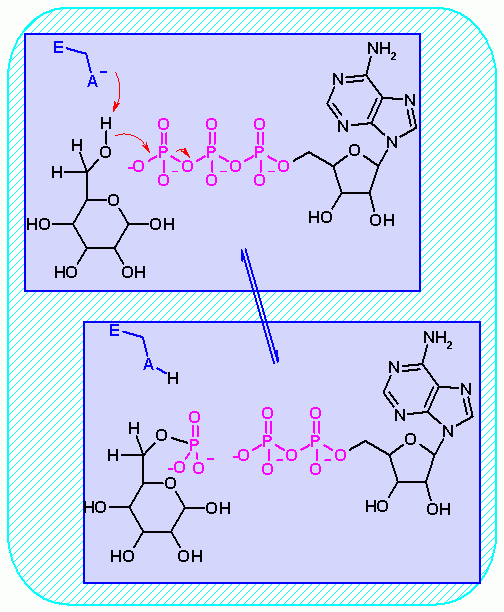 Hexokinase Information
Hexokinase Information
 Hexokinase Information
Hexokinase Information
|
Enzyme Name |
Hexokinase |
|
|
Reaction Catalyzed |
ATP dependent phosphorylation of Glucose
|
|
|
Reaction Type |
Group Transfer |
|
|
Rationale |
Most cellular metabolites are charged. The reason is to maintain them inside the cell. uncharged molecules, like glucose for instance, are free to diffuse through the cell membrane, but charged molecules cannot diffuse through the membrane. Remember the "core" of the membrane is hydrophobic. Charged molecules and hydrophobic ones do not mix well. A good source of charge at pH 7 will be phosphate groups. Once a cell begins the metabolic processes on a specific molecule it would be a shame if it left the cell and went somewhere else. Like money in your bank account, you sure do not want it "leaking" to other accounts in the bank! So the first step in glycolysis is to put a phosphate on the glucose, in an ATP dependent group transfer. Why does it NEED to be an ATP dependent group transfer? why not just put a phosphate on using a condensation reaction (reverse of a hydrolysis)? Think thermodynamics here... What do we know about the thermodynamics of hydrolysis reactions How many places on glucose COULD the phosphate be transferred to? It is important to recall the mechanism of group transfer reactions here. COULD it be transferred to C6 (the alcohol at the "top"); to C1 (the aldehyde on the right)? Why or why not? |
|
|
Pathway involvement |
Glycolysis ONLY |
Hexokinase is not part of the gluconeogenesis pathway. In gluconeogenesis a separate enzyme (Glucose-6-Phosphatase) hydrolyzes a phosphate from Glucose-6P and is not ATP dependent. Rather it performs a simple hydrolysis reaction to cleave off phosphate. |
|
Cofactors/Cosubstrates |
ATP is a cosubstrate; ADP is a coproduct |
|
|
DGo' |
-16 kJ/M |
Starting from standard state and allowing the reaction to come to equilibrium the product concentrations would end up ~600 times higher than the substrates. This extremely favorable Standard Free Energy is helpful to get the entire pathway rolling in the right direction. |
|
Keq |
~600= |
|
|
Comments |
Why is ATP required? What would the DGo' for putting a phosphate on glucose be if we used inorganic phosphate (reversal of a hydrolysis reaction) instead of ATP? It would be +15 kJ/M. Which direction would be favored then? |
|
|
Substrate Concentrations* |
||
|
S1= |
Glucose |
5mM |
|
S2= |
ATP |
2mM |
|
P1= |
Glucose-6-phosphate |
0.83 mM |
|
P2= |
ADP |
0.14 mM |
|
DG for these conditions |
 |
|
|
-27 kJ/M |
||
|
Mechanism for Chemistry |
 |
|
|
Mechanism for Enzyme |
 |
|
|
Picture of Enzyme No Substrate |
 |
All atoms of the enzyme represented by colored spheres. That active site Aspartate that acts as the base to initiate the reaction is colored green |
|
Picture of Enzyme with substrate bound |
 |
All atoms of the enzyme represented by colored spheres. Active site Aspartate is colored green the substrate is purple. Notice how much the enzyme structure has "closed". The effect to make sure that water is not in the active site at the same time as the substrates. If water were present it could easily be activated to hydrolyze ATP. |
|
Active site Aspartate + "Glucose" |
 |
Close up of the active site with "substrate" bound. The active site Asparate is on the right. Notice how it is "perfectly" aligned to act as the base to remove a H+ from the substrate hydroxyl group. |
*= These are concentrations obtained for one set of conditions. These will change as physiology and activity change.